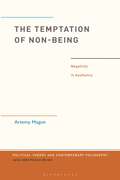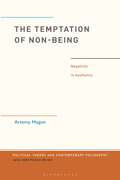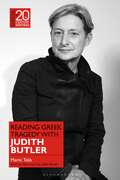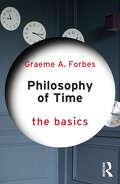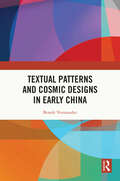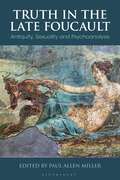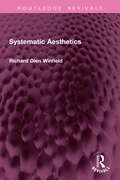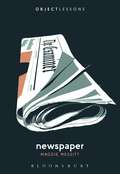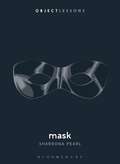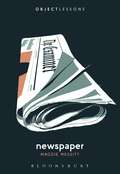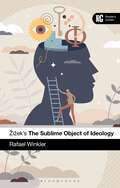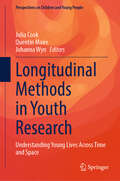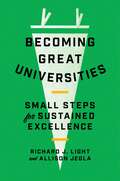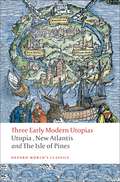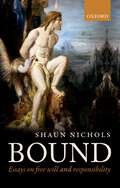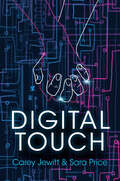- Table View
- List View
The Temptation of Non-Being: Negativity in Aesthetics (Political Theory and Contemporary Philosophy)
by Dr. Artemy MagunWhy do we enjoy artworks that depict disasters and suffering? Is this a hangover from the Modernist impulse to break the rules of harmony? Is there actually a proper way to perform negativity in art without resorting to nihilism? The Temptation of Non-Being uses these fundamental questions to paint a picture of contemporary art as beset by an outbreak of the negative, and to construct a new theory of art as a medium of complex negativity. The negative in art is explained not as a simple negation or destruction, but as a multifaceted, polymorphous structure with a vast range of strategies and techniques from parody and pastiche to defamiliarization and non-resemblance. Charting the depth of these negative practices, Artemy Magun shows how they become progressively more complex and explicit, illustrating them with interdisciplinary examples from Lars von Trier, Jacek Malczewski, Andrei Platonov and Fyodor Dostoyevsky. At the heart of this layered, nested structure lies an understanding of Modern aesthetics that helps to answer even more questions: how can the testing, probing nature of art lead to this preoccupation with the negative? Why does this negativity emerge in the first place? What can it tell us about art itself and how it functions in society? This is an erudite and provocative analysis that enriches the ongoing evaluation of both 'high' and 'low' art.
The Temptation of Non-Being: Negativity in Aesthetics (Political Theory and Contemporary Philosophy)
by Dr. Artemy MagunWhy do we enjoy artworks that depict disasters and suffering? Is this a hangover from the Modernist impulse to break the rules of harmony? Is there actually a proper way to perform negativity in art without resorting to nihilism? The Temptation of Non-Being uses these fundamental questions to paint a picture of contemporary art as beset by an outbreak of the negative, and to construct a new theory of art as a medium of complex negativity. The negative in art is explained not as a simple negation or destruction, but as a multifaceted, polymorphous structure with a vast range of strategies and techniques from parody and pastiche to defamiliarization and non-resemblance. Charting the depth of these negative practices, Artemy Magun shows how they become progressively more complex and explicit, illustrating them with interdisciplinary examples from Lars von Trier, Jacek Malczewski, Andrei Platonov and Fyodor Dostoyevsky. At the heart of this layered, nested structure lies an understanding of Modern aesthetics that helps to answer even more questions: how can the testing, probing nature of art lead to this preoccupation with the negative? Why does this negativity emerge in the first place? What can it tell us about art itself and how it functions in society? This is an erudite and provocative analysis that enriches the ongoing evaluation of both 'high' and 'low' art.
Reading Greek Tragedy with Judith Butler (Classical Receptions in Twentieth-Century Writing)
by Professor Mario TelòConsidering Butler's “tragic trilogy”-a set of interventions on Sophocles' Antigone, Euripides' Bacchae, and Aeschylus's Eumenides-this book seeks to understand not just how Butler uses and interprets Greek tragedy, but also how tragedy shapes Butler's thinking, even when their gaze is directed elsewhere. Through close readings of these tragedies, this book brings to light the tragic quality of Butler's writing. It shows how Butler's mode of reading tragedy-and, crucially, reading tragically-offers a distinctive ethico-political response to the harrowing dilemmas of our current moment. Deeply committed both to critical theory and political activism, Judith Butler is one of the most influential intellectuals today. Their ideas have touched the lives of many people, both readers and those who have never heard Butler's name. In encompassing gender performativity and sexual difference, vulnerability and precarity, disidentification and bodily interdependency, as well as the politics of protest, Butler's work is often predicated on a strong engagement with or proximity to Greek tragedy.
Reading Greek Tragedy with Judith Butler (Classical Receptions in Twentieth-Century Writing)
by Professor Mario TelòConsidering Butler's “tragic trilogy”-a set of interventions on Sophocles' Antigone, Euripides' Bacchae, and Aeschylus's Eumenides-this book seeks to understand not just how Butler uses and interprets Greek tragedy, but also how tragedy shapes Butler's thinking, even when their gaze is directed elsewhere. Through close readings of these tragedies, this book brings to light the tragic quality of Butler's writing. It shows how Butler's mode of reading tragedy-and, crucially, reading tragically-offers a distinctive ethico-political response to the harrowing dilemmas of our current moment. Deeply committed both to critical theory and political activism, Judith Butler is one of the most influential intellectuals today. Their ideas have touched the lives of many people, both readers and those who have never heard Butler's name. In encompassing gender performativity and sexual difference, vulnerability and precarity, disidentification and bodily interdependency, as well as the politics of protest, Butler's work is often predicated on a strong engagement with or proximity to Greek tragedy.
Philosophy of Time: The Basics (The Basics)
by Graeme ForbesWhat is time? Does it pass? Is the future open? Why do we care? Philosophy of Time: The Basics doesn’t answer these questions. It does give you an opinionated introduction to thinking a bit more deeply about them. Written in a way that assumes no philosophical background from its readers, this book looks at central topics in philosophy of time and shows how they relate to other time-related topics – from theoretical physics (without the maths!) to your own mortality. Additional questions include: In what way is time different to space? How long is the present? Does the Theory of Relativity show time doesn’t pass? What makes time have a direction or ‘arrow’? Can you be harmed by your own death? Allowing the reader to think more deeply about time, this book begins to untangle some of the most difficult knots in all of philosophy. It also provides practical advice to prospective time-travelers.
Philosophy of Time: The Basics (The Basics)
by Graeme ForbesWhat is time? Does it pass? Is the future open? Why do we care? Philosophy of Time: The Basics doesn’t answer these questions. It does give you an opinionated introduction to thinking a bit more deeply about them. Written in a way that assumes no philosophical background from its readers, this book looks at central topics in philosophy of time and shows how they relate to other time-related topics – from theoretical physics (without the maths!) to your own mortality. Additional questions include: In what way is time different to space? How long is the present? Does the Theory of Relativity show time doesn’t pass? What makes time have a direction or ‘arrow’? Can you be harmed by your own death? Allowing the reader to think more deeply about time, this book begins to untangle some of the most difficult knots in all of philosophy. It also provides practical advice to prospective time-travelers.
Textual Patterns and Cosmic Designs in Early China
by Benoît VermanderVia a hermeneutics focused on Chinese numerology and concentric arrangements, this book offers a novel construal of the textual universe proper to early China writings.The author lays bare distinguishable patterns of textual composition while relating them to corresponding patterns of thinking. He differentiates rhetorical variants through detailed studies of the Zhuangzi’s Inner chapters, the Laozi, the Analects, and the Huainanzi. The philosophical depth and relevance of the Chinese ancient worldview appear in a fresh light when one unearths the patterns into which its content is embedded. The focus on textual patterns and rhetorical arrangements also facilitates the reading of Chinese classics alongside other traditions.The book will be a valuable reference for scholars and graduate students studying Chinese literary criticism, Chinese philosophy, and comparative philosophy.
Textual Patterns and Cosmic Designs in Early China
by Benoît VermanderVia a hermeneutics focused on Chinese numerology and concentric arrangements, this book offers a novel construal of the textual universe proper to early China writings.The author lays bare distinguishable patterns of textual composition while relating them to corresponding patterns of thinking. He differentiates rhetorical variants through detailed studies of the Zhuangzi’s Inner chapters, the Laozi, the Analects, and the Huainanzi. The philosophical depth and relevance of the Chinese ancient worldview appear in a fresh light when one unearths the patterns into which its content is embedded. The focus on textual patterns and rhetorical arrangements also facilitates the reading of Chinese classics alongside other traditions.The book will be a valuable reference for scholars and graduate students studying Chinese literary criticism, Chinese philosophy, and comparative philosophy.
Truth in the Late Foucault: Antiquity, Sexuality, and Psychoanalysis (Bloomsbury Studies in Classical Reception)
by Paul Allen MillerThe first full treatment of truth as a core philosophical concept in the late Foucault, this volume examines his work on the ancient world and the early church. Each essay features a deep examination as to how the topics of truth and sexuality intersect with and focus on Foucault's engagement with ancient philosophy and thought. Truth in the Late Foucault offers readings on Plato, Artemidorus, Cicero, Sophocles and the Stoics, and pays close attention to Cassian, Paulinus of Nola, and early Christian practices of confession. With the publication of the long-awaited volume 4 of the History of Sexuality: Confessions of the Flesh, the shape of the final Foucault is now brought into stark relief. As well as looking at ancient thought, the contributors explore Foucault's work in relation to philosophers such as Gadamer, Heidegger, Derrida and Descartes. Foucault's long-running and often contentious dialogue with psychoanalysis, on the relation between truth and the subject, is also examined. Each essay not only makes an important statement, but also is part of an interconnected arc of topics and understanding, covering both the ancient and modern periods. This book reveals that Foucault's concern with antiquity raises questions deeply pertinent to the present moment.
Systematic Aesthetics (Routledge Revivals)
by Richard WinfieldFirst published in 1995, this book aims at rehabilitating systematic aesthetics. To this end, it attempts to show how metaphysical, transcendental, and systematic aesthetics comprise the fundamental options for the philosophy of art, how metaphysical and transcendental aesthetics internally undermine themselves, and, finally, how their dilemmas are overcome by systematic aestheticsIt discusses themes like critique of metaphysical aesthetics; impasse of transcendental aesthetics; individuality of beauty; the existence of beauty in the work of art; the extreme reality of the work of art and the reception of art. This is a must read for scholars and researchers of philosophy of art and philosophy in general.
Systematic Aesthetics (Routledge Revivals)
by Richard WinfieldFirst published in 1995, this book aims at rehabilitating systematic aesthetics. To this end, it attempts to show how metaphysical, transcendental, and systematic aesthetics comprise the fundamental options for the philosophy of art, how metaphysical and transcendental aesthetics internally undermine themselves, and, finally, how their dilemmas are overcome by systematic aestheticsIt discusses themes like critique of metaphysical aesthetics; impasse of transcendental aesthetics; individuality of beauty; the existence of beauty in the work of art; the extreme reality of the work of art and the reception of art. This is a must read for scholars and researchers of philosophy of art and philosophy in general.
Truth in the Late Foucault: Antiquity, Sexuality, and Psychoanalysis (Bloomsbury Studies in Classical Reception)
The first full treatment of truth as a core philosophical concept in the late Foucault, this volume examines his work on the ancient world and the early church. Each essay features a deep examination as to how the topics of truth and sexuality intersect with and focus on Foucault's engagement with ancient philosophy and thought. Truth in the Late Foucault offers readings on Plato, Artemidorus, Cicero, Sophocles and the Stoics, and pays close attention to Cassian, Paulinus of Nola, and early Christian practices of confession. With the publication of the long-awaited volume 4 of the History of Sexuality: Confessions of the Flesh, the shape of the final Foucault is now brought into stark relief. As well as looking at ancient thought, the contributors explore Foucault's work in relation to philosophers such as Gadamer, Heidegger, Derrida and Descartes. Foucault's long-running and often contentious dialogue with psychoanalysis, on the relation between truth and the subject, is also examined. Each essay not only makes an important statement, but also is part of an interconnected arc of topics and understanding, covering both the ancient and modern periods. This book reveals that Foucault's concern with antiquity raises questions deeply pertinent to the present moment.
Newspaper (Object Lessons)
by Dr. Maggie MessittObject Lessons is a series of short, beautifully designed books about the hidden lives of ordinary things.Newspaper is about more than news printed on paper. It brings us inside our best and worst selves, from censorship and the intentional destruction of historic record, to partisan and white supremacist campaigns, to the story of an instrument that has been central to democracy and to holding the powerful to account. This is a 400-year history of a nearly-endangered object as seen by journalist Maggie Messitt in the two democratic nations she calls home – the United States and South Africa.The “first draft of history,” newspapers figure prominently through each movement and period of unrest in both nations-from the first colonial papers published by slave traders and an advocate for press freedom to those published on id cards, wallpaper, and folio sheets during civil wars. Offices were set on fire. Presses were pushed into bodies of water. Editors were run out of town. And journalists were arrested.Newspaper reflects on a tool that has been used to push down and to rise up, and a journey alongside the hidden lives that have harnessed its power.Object Lessons is published in partnership with an essay series in The Atlantic.
Mask (Object Lessons)
by Dr. Sharrona PearlObject Lessons is a series of short, beautifully designed books about the hidden lives of ordinary things.From the theater mask and masquerade to the masked criminal and the rise of facial recognition software, masks have long performed as an instrument for the protection and concealment of identity. Even as they conceal and protect, masks – as faces – are an extension of the self. At the same time, they are a part of material culture: what are masks made of? What traces do they leave behind? Acknowledging that that mask-wearing has become increasingly weaponized and politicized, Sharrona Pearl looks at the politics of the mask, exploring how identity itself is read on this object.By exploring who we do (and do not) seek to protect through different forms of masking, Sharrona Pearl's long history of masks helps us to better understand what it is we value. Object Lessons is published in partnership with an essay series in The Atlantic.
Newspaper (Object Lessons)
by Dr. Maggie MessittObject Lessons is a series of short, beautifully designed books about the hidden lives of ordinary things.Newspaper is about more than news printed on paper. It brings us inside our best and worst selves, from censorship and the intentional destruction of historic record, to partisan and white supremacist campaigns, to the story of an instrument that has been central to democracy and to holding the powerful to account. This is a 400-year history of a nearly-endangered object as seen by journalist Maggie Messitt in the two democratic nations she calls home – the United States and South Africa.The “first draft of history,” newspapers figure prominently through each movement and period of unrest in both nations-from the first colonial papers published by slave traders and an advocate for press freedom to those published on id cards, wallpaper, and folio sheets during civil wars. Offices were set on fire. Presses were pushed into bodies of water. Editors were run out of town. And journalists were arrested.Newspaper reflects on a tool that has been used to push down and to rise up, and a journey alongside the hidden lives that have harnessed its power.Object Lessons is published in partnership with an essay series in The Atlantic.
Mask (Object Lessons)
by Dr. Sharrona PearlObject Lessons is a series of short, beautifully designed books about the hidden lives of ordinary things.From the theater mask and masquerade to the masked criminal and the rise of facial recognition software, masks have long performed as an instrument for the protection and concealment of identity. Even as they conceal and protect, masks – as faces – are an extension of the self. At the same time, they are a part of material culture: what are masks made of? What traces do they leave behind? Acknowledging that that mask-wearing has become increasingly weaponized and politicized, Sharrona Pearl looks at the politics of the mask, exploring how identity itself is read on this object.By exploring who we do (and do not) seek to protect through different forms of masking, Sharrona Pearl's long history of masks helps us to better understand what it is we value. Object Lessons is published in partnership with an essay series in The Atlantic.
Žižek's The Sublime Object of Ideology: A Reader’s Guide (Reader's Guides)
by Rafael WinklerFirst published in 1989, The Sublime Object of Ideology was Žižek's breakthrough work, and is still regarded by many as his masterpiece. It was an iconoclastic reinvention of ideology critique that introduced the English-speaking world to Žižek's scorching brand of cultural and philosophical commentary and the multifaceted ways in which he explained it. Tying together concepts from aesthetics, psychoanalytic theory, cultural studies and the philosophy of belief, it changed the face of contemporary commentary and remains the underpinning of much of his subsequent thinking. This compelling guide introduces all of the influential thinkers and foundational concepts which Žižek draws on to create this seminal work. Grounding the text's many and varied references in the work of Peter Sloterdijk, Saul Kripke, Walter Benjamin, Jacques Lacan, Jacques Derrida, Immanuel Kant and G.W.F. Hegel, amongst others, helps students who are encountering this mercurial writer for the first time to understand the philosophical context of his early explorations. Each of Žižek's key arguments are unpacked and laid out, alongside an invaluable account of how The Sublime Object of Ideology impacted the critical terrain on which it landed.
Žižek's The Sublime Object of Ideology: A Reader’s Guide (Reader's Guides)
by Rafael WinklerFirst published in 1989, The Sublime Object of Ideology was Žižek's breakthrough work, and is still regarded by many as his masterpiece. It was an iconoclastic reinvention of ideology critique that introduced the English-speaking world to Žižek's scorching brand of cultural and philosophical commentary and the multifaceted ways in which he explained it. Tying together concepts from aesthetics, psychoanalytic theory, cultural studies and the philosophy of belief, it changed the face of contemporary commentary and remains the underpinning of much of his subsequent thinking. This compelling guide introduces all of the influential thinkers and foundational concepts which Žižek draws on to create this seminal work. Grounding the text's many and varied references in the work of Peter Sloterdijk, Saul Kripke, Walter Benjamin, Jacques Lacan, Jacques Derrida, Immanuel Kant and G.W.F. Hegel, amongst others, helps students who are encountering this mercurial writer for the first time to understand the philosophical context of his early explorations. Each of Žižek's key arguments are unpacked and laid out, alongside an invaluable account of how The Sublime Object of Ideology impacted the critical terrain on which it landed.
Longitudinal Methods in Youth Research: Understanding Young Lives Across Time and Space (Perspectives on Children and Young People #15)
by Johanna Wyn Julia Cook Quentin MaireThis book addresses how longitudinal research approaches are used to understand young people’s lives. It elucidates how youth researchers use longitudinal approaches, and how longitudinal research can help us to both understand and shape the field of youth sociology. Chapters discuss the creation of knowledge about youth and how longitudinal research shapes the field of youth sociology and shed light on key tensions and emerging debates in longitudinal youth research ranging from research design to data collection, analysis, and use. It considers longitudinal studies using a broad range of methods, including qualitative, quantitative, mixed methods, retrospective methods, and creative and participatory methods. This collection offers insights from longitudinal youth scholars conducting research in Argentina, Lithuania, Australia, Estonia, Canada, the United States (US), the United Kingdom (UK), Finland and India. These researchers reflect on the future of longitudinal youth research, addressing emerging and prospective issues. This book provides a concise survey of key established and emerging areas of concern in longitudinal research and of the relationship between these areas and the field of youth studies more specifically.
Becoming Great Universities: Small Steps for Sustained Excellence
by Richard J. Light Allison JeglaHow campus communities of every kind can transform themselves from good to greatBecoming Great Universities highlights ten core challenges that all colleges and universities face and offers practical steps that everyone on campus—from presidents to first-year undergraduates—can take to enhance student life and learning.This incisive book, written in a friendly and engaging style, draws on conversations with presidents, deans, and staff at hundreds of campuses across the country as well as scores of in-depth interviews with students and faculty. Providing suggestions that all members of a campus community can implement, Richard Light and Allison Jegla cover topics such as how to build a culture of innovation on campus, how to improve learning outcomes through experimentation, how to help students from under-resourced high schools succeed in college, and how to attract students from rural areas who may not be considering colleges far from their communities. They offer concrete ways to facilitate constructive interactions among students from different backgrounds, create opportunities for lifelong learning and engagement, and inspire students to think globally. And most of the ideas presented in this book can be implemented at little to no cost.Featuring a wealth of evidence-based examples, Becoming Great Universities offers actionable suggestions for everyone to have a positive impact on college life regardless of whether their campus is urban or rural, private or public, large or small, wealthy or not.
Three Early Modern Utopias: Thomas More: Utopia / Francis Bacon: New Atlantis / Henry Neville: The Isle of Pines (Oxford World's Classics)
by Francis Bacon Thomas More Henry NevilleThomas More: Utopia/ Francis Bacon: New Atlantis/Henry Neville: The Isle of Pines With the publication of Utopia (1516), Thomas More introduced into the English language not only a new word, but a new way of thinking about the gulf between what ought to be and what is. His Utopia is at once a scathing analysis of the shortcomings of his own society, a realistic suggestion for an alternative mode of social organization, and a satire on unrealistic idealism. Enormously influential, it remains a challenging as well as a playful text. This edition reprints Ralph Robinson's 1556 translation from More's original Latin together with letters and illustrations that accompanied early editions of Utopia. Utopia was only one of many early modern treatments of other worlds. This edition also includes two other, hitherto less accessible, utopian narratives. New Atlantis (1627) offers a fictional illustration of Francis Bacon's visionary ideal of the role that science should play in the modern society. Henry Neville's The Isle of Pines (1668), a precursor of Defoe's Robinson Crusoe, engages with some of the sexual, racial, and colonialist anxieties of the end of the early modern period. Together these texts illustrate the diversity of the early modern utopian imagination, as well as the different purposes to which it could be put. ABOUT THE SERIES: For over 100 years Oxford World's Classics has made available the widest range of literature from around the globe. Each affordable volume reflects Oxford's commitment to scholarship, providing the most accurate text plus a wealth of other valuable features, including expert introductions by leading authorities, helpful notes to clarify the text, up-to-date bibliographies for further study, and much more.
Bound: Essays on free will and responsibility
by Shaun NicholsThe problem of free will arises from ordinary, commonsense reflection. Shaun Nichols examines these ordinary attitudes from a naturalistic perspective. He offers a psychological account of the origins of the problem of free will. According to his account the problem arises because of two naturally emerging ways of thinking about ourselves and the world, one of which makes determinism plausible while the other makes determinism implausible. Although contemporary cognitive science does not settle whether choices are determined, Nichols argues that our belief in indeterminist choice is grounded in faulty inference and should be regarded as unjustified. However, even if our belief in indeterminist choice is false, it's a further substantive question whether that means that free will doesn't exist. Nichols argues that, because of the flexibility of reference, there is no single answer to whether free will exists. In some contexts, it will be true to say 'free will exists'; in other contexts, it will be false to say that. With this substantive background in place, Bound promotes a pragmatic approach to prescriptive issues. In some contexts, the prevailing practical considerations suggest that we should deny the existence of free will and moral responsibility; in other contexts the practical considerations suggest that we should affirm free will and moral responsibility. This allows for the possibility that in some contexts, it is morally apt to exact retributive punishment; in other contexts, it can be apt to take up the exonerating attitude of hard incompatibilism.
Bound: Essays on free will and responsibility
by Shaun NicholsThe problem of free will arises from ordinary, commonsense reflection. Shaun Nichols examines these ordinary attitudes from a naturalistic perspective. He offers a psychological account of the origins of the problem of free will. According to his account the problem arises because of two naturally emerging ways of thinking about ourselves and the world, one of which makes determinism plausible while the other makes determinism implausible. Although contemporary cognitive science does not settle whether choices are determined, Nichols argues that our belief in indeterminist choice is grounded in faulty inference and should be regarded as unjustified. However, even if our belief in indeterminist choice is false, it's a further substantive question whether that means that free will doesn't exist. Nichols argues that, because of the flexibility of reference, there is no single answer to whether free will exists. In some contexts, it will be true to say 'free will exists'; in other contexts, it will be false to say that. With this substantive background in place, Bound promotes a pragmatic approach to prescriptive issues. In some contexts, the prevailing practical considerations suggest that we should deny the existence of free will and moral responsibility; in other contexts the practical considerations suggest that we should affirm free will and moral responsibility. This allows for the possibility that in some contexts, it is morally apt to exact retributive punishment; in other contexts, it can be apt to take up the exonerating attitude of hard incompatibilism.
Three Early Modern Utopias: Thomas More: Utopia / Francis Bacon: New Atlantis / Henry Neville: The Isle of Pines (Oxford World's Classics)
by Francis Bacon Thomas More Henry NevilleThomas More: Utopia/ Francis Bacon: New Atlantis/Henry Neville: The Isle of Pines With the publication of Utopia (1516), Thomas More introduced into the English language not only a new word, but a new way of thinking about the gulf between what ought to be and what is. His Utopia is at once a scathing analysis of the shortcomings of his own society, a realistic suggestion for an alternative mode of social organization, and a satire on unrealistic idealism. Enormously influential, it remains a challenging as well as a playful text. This edition reprints Ralph Robinson's 1556 translation from More's original Latin together with letters and illustrations that accompanied early editions of Utopia. Utopia was only one of many early modern treatments of other worlds. This edition also includes two other, hitherto less accessible, utopian narratives. New Atlantis (1627) offers a fictional illustration of Francis Bacon's visionary ideal of the role that science should play in the modern society. Henry Neville's The Isle of Pines (1668), a precursor of Defoe's Robinson Crusoe, engages with some of the sexual, racial, and colonialist anxieties of the end of the early modern period. Together these texts illustrate the diversity of the early modern utopian imagination, as well as the different purposes to which it could be put. ABOUT THE SERIES: For over 100 years Oxford World's Classics has made available the widest range of literature from around the globe. Each affordable volume reflects Oxford's commitment to scholarship, providing the most accurate text plus a wealth of other valuable features, including expert introductions by leading authorities, helpful notes to clarify the text, up-to-date bibliographies for further study, and much more.
Digital Touch
by Carey Jewitt Sara PriceTouch matters. It is fundamental to how we know ourselves and each other, and it is central to how we communicate. Digital touch is embedded in many technologies, from wearable devices and gaming hardware to tactile robots and future technologies. What would it be like if we could hug or touch digitally across distance? How might this shape our sense of connection? How might we establish trust or protect our privacy and safety? Digital Touch is a timely and original book that addresses such questions. Offering a rich account of digital touch, the book introduces the key issues and debates, as well as the design and ethical challenges raised by digital touch. Using clear, accessible examples and creative scenarios, the book shows how touch – how we touch, as well as what, whom and when we touch – is being profoundly reshaped by our use of technologies. Above all, it highlights the importance of digital touch in our daily lives and how it will impact our relationships and way of life in the future. The first work of its kind, Digital Touch is the go-to book for anyone wanting to get to grips with this crucial emerging topic, especially students and scholars of Digital Media and Communication Studies, Digital Humanities, Sensory Studies, and Science and Technology Studies.
